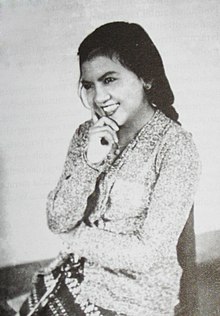Soerip
Anastasya Soerip | |
|---|---|
 Promotional image of Soerip for Panggilan Darah (1941) | |
| Born | 22 October 1921 |
| Died | 7 May 1992 (aged 70) |
| Occupation | Actress |
| Years active | 1940s–1990s |
Soerip (Perfected Spelling: Surip; 22 October 1921 – 7 May 1992) was an Indonesian singer and film actress.
Biography
Soerip was born in Banyuwangi, East Java, Dutch East Indies, on 22 October 1921. She only completed two years of elementary school before she dropped out.[1] She later became a kroncong singer, often billed as Miss Soerip. Owing to her habit of batting her eyelashes while singing, she was also nicknamed "Si Mata Roda".[2]
In 1940 Soerip made her feature film debut in Zoebaida, directed by Njoo Cheong Seng for Oriental Film.[2] This was followed in 1941 by Panggilan Darah, in which Soerip was cast with Dhalia as orphaned sisters who try to make a living in the colonial capital of Batavia (now Jakarta).[3] When the company folded, unable to recoup its expenses,[4] Soerip migrated to Majestic Film. She completed three productions for the company: Air Mata Iboe, Djantoeng Hati, and Pantjawarna.[5]
After the Japanese occupation of the Indies in March 1942, in which all but one domestic film studio was shut down, Soerip took a thirty-year hiatus from film, only returning to the industry in 1973 for Sopir Taxi. Owing to her age, she took the honorific Mbah (Grandmother), and was billed Mbah Soerip.[2] During the following two decades she completed a further 20 films, including productions by Slamet Rahardjo, Teguh Karya, and Wim Umboh.[5] A retrospective in Apa Siapa Film Indonesia particularly praises her performance in Rahardjo's Rembulan dan Matahari (1979).[6]
In 1990 Soerip made her last film, Cintaku di Way Kambas, and a soap opera, Bayang-Bayang. That year she was recognised by the National Film Council for her dedication to acting.[2] Soerip died on 7 May 1992 in Jakarta.[2]
Filmography
|
|
References
- ^ Biran 1979, p. 480.
- ^ a b c d e JCG, Soerip, Miss.
- ^ Filmindonesia.or.id, Panggilan Darah.
- ^ Biran 2009, p. 229.
- ^ a b Filmindonesia.or.id, Soerip.
- ^ Apa Siapa 1999, p. 403.
Works cited
- Apa Siapa Orang Film Indonesia (in Indonesian). Jakarta: Indonesian Ministry of Information. 1999. OCLC 44427179.
{{cite book}}: Unknown parameter|trans_title=ignored (|trans-title=suggested) (help) - Biran, Misbach Yusa, ed. (1979). Apa Siapa Orang Film Indonesia 1926–1978. Sinematek Indonesia. OCLC 6655859.
{{cite book}}: Invalid|ref=harv(help); Unknown parameter|trans_title=ignored (|trans-title=suggested) (help) - Biran, Misbach Yusa (2009). Sejarah Film 1900–1950: Bikin Film di Jawa (in Indonesian). Jakarta: Komunitas Bamboo working with the Jakarta Art Council. ISBN 978-979-3731-58-2.
{{cite book}}: Invalid|ref=harv(help); Unknown parameter|trans_title=ignored (|trans-title=suggested) (help) - "Filmografi Soerip". filmindonesia.or.id (in Indonesian). Jakarta: Konfiden Foundation. Archived from the original on 30 March 2013. Retrieved 30 March 2013.
{{cite web}}: Unknown parameter|trans_title=ignored (|trans-title=suggested) (help) - "Panggilan Darah". filmindonesia.or.id (in Indonesian). Jakarta: Konfiden Foundation. Archived from the original on 26 July 2012. Retrieved 26 July 2012.
- "Soerip, Miss". Encyclopedia of Jakarta (in Indonesian). Jakarta City Government. Archived from the original on 30 March 2013. Retrieved 30 March 2013.
